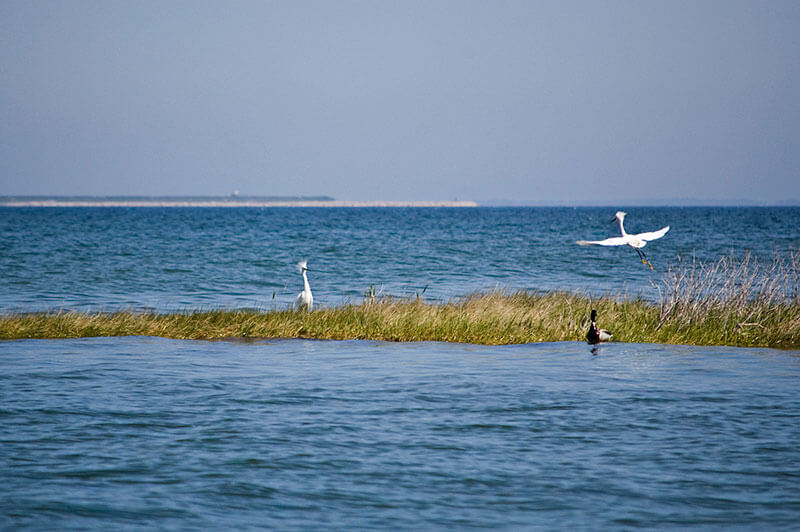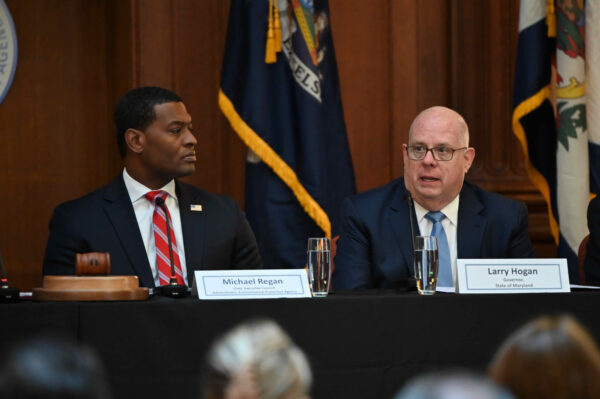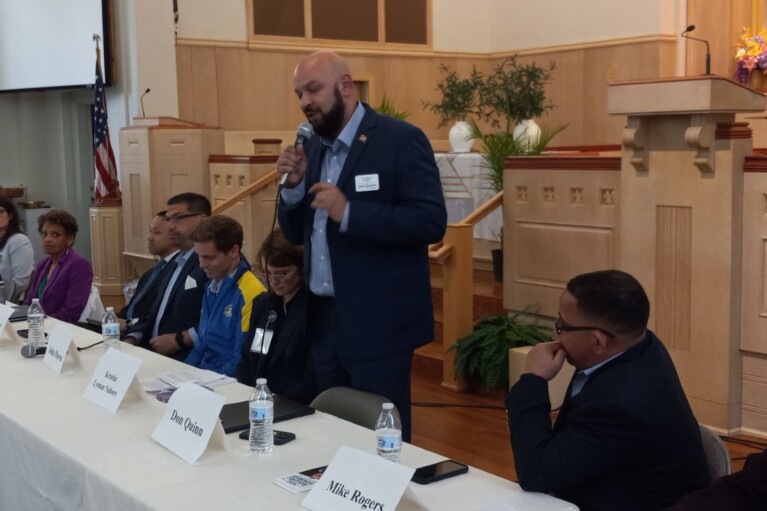Chesapeake Bay leaders resolute even as cleanup targets become more elusive

As a 2025 federal deadline for states to meet ambitious goals for cleaning up the Chesapeake Bay draws closer, it is starting to dawn on state and U.S. officials and other stakeholders that some states will fall short. Virginia Gov. Glenn Youngkin (R) admitted as much on Tuesday.
“That was a difficult recognition,” he said. “I think we have a clear commitment to meeting those goals. Unfortunately, it won’t be by 2025.”
Youngkin made his remarks at the annual meeting of the Chesapeake Bay Executive Council, which brings the leaders of states in the Bay watershed together with federal officials and other leaders to assess the state of the Bay’s health. Tuesday’s meeting was held at the headquarters of the U.S. Environmental Protection Agency, which has just issued its own mixed though generally sunny assessment.
These meetings are usually a chance for governors and cabinet secretaries and other officials to boast about the progress being made cleaning up the Chesapeake Bay — progress that they say is tangible and real.
“It is clear that so many positive developments have been made despite the emerging threats of climate change and with the growing population,” said Kandis Boyd, the new director of EPA’s 39-year-old Chesapeake Bay Program.
But the enthusiasm was dampened by knowledge that some states won’t meet their targeted goals by 2025. Still, U.S. EPA Administrator Michael Regan, who was chairing the meeting, said that officials from all six Bay states and the District of Columbia are committed to attaining the pollution reduction goals. It’s up to environmental agency officials in each state, he said, to figure out which goals are realistic, how to expedite certain plans of action, and to reconsider how to ensure that the lagging targets are met as quickly as possible.
“I think we’ve all acknowledged that 2025 is fleeting in terms of achieving all of our substantial goals,” Regan said. “We intend to set reasonable achievable goals in a timeline that can help us [eventually] meet our broader, more ambitious goals.”
He added that the bipartisan federal infrastructure bill that became law last year will provide an additional $90 million a year over the next five years earmarked for Chesapeake Bay cleanup. That will go to state and local governments, agricultural groups, watermen and nonprofits, among others.

Gov. Larry Hogan (right) and U.S. EPA Administrator Michael Regan at a meeting of the Chesapeake Bay Executive Council at EPA headquarters Tuesday. Photo from the Executive Office of the Governor.
In an interview, Hillary Harp Falk, president of the Chesapeake Bay Foundation, which issued its own report last week on the health of the Bay, complete with warnings about how certain states are falling short, said she was pleased that state and federal leaders publicly recommitted to meeting the cleanup goals.
But she added, “We need strong state leadership and federal accountability to get close to 2025. The devil’s in the details.”
The Choose Clean Water Coalition, which consists of more than 270 nonprofit groups in the Chesapeake watershed, expressed similar sentiments.
“We are focused on the actions that will follow the words shared this afternoon from the members of the Executive Council,” said the coalition’s executive director, Kristin Reilly. “If we are to provide clean water to all 18 million people whose local waterways feed the Bay, we need accountability and sufficient investments to ensure we meet our commitments.”
Without naming him, Youngkin sought to pin some of the blame for Virginia’s shortfall on his predecessor, former Gov. Ralph Northam (D), an Eastern Shore native, saying “the previous administration wasn’t completely transparent about how they went about setting their agenda.” He suggested that the Northam administration did not provide adequate funding for Bay cleanup and also set “artificial expiration dates” for certain programs.
“I’m a homegrown Virginia boy,” Youngkin asserted. “Not just in Virginia, but in Virginia Beach, and the Chesapeake means a whole lot to me personally. I grew up on it. I love the Bay and I want other folks to have the chance to love it just as much as I do.”
Youngkin brought with him Andrew Wheeler, a former coal company lobbyist who served as EPA administrator during the Trump administration and is now advising the Virginia governor on environmental matters. Environmentalists have harshly criticized Youngkin’s association with Wheeler.
Maryland has two representatives on the Chesapeake Bay Executive Council: Gov. Larry Hogan (R) and state Sen. Sarah Elfreth (D-Anne Arundel), who is chair of the Chesapeake Bay Commission, a group of state legislators from Maryland, Virginia and Pennsylvania who meet regularly to discuss Bay policy. There was no partisan rancor between Hogan and Elfreth on display. Both praised Pennsylvania, which until recently has widely been seen as lagging behind other states in meeting Bay cleanup goals, for new legislation to limit the use of fertilizer and for establishing a Clean Streams Fund.
Elfreth also noted that Virginia had adopted a revolving loan fund for climate resilience programs, adopted a flood protection master plan, hired a chief resiliency officer — a program Maryland is emulating — and has begun teaching environmental literacy.
Meanwhile, “in Maryland, we had one of our best sessions yet,” Elfreth said, referencing passage of the Climate Solutions Now Act, a bill to ban the chemical PFAS, and to support oyster restoration programs.
“But there is so much more work ahead,” she said.
Ann Swanson, executive director of the Chesapeake Bay Commission, who is retiring later this fall after more than 30 years on the job, reminded the governors of the unique role they play in ensuring the Bay’s health — not just because of their impact on policy but because of their ability to shape the public conversation.
“You have voices that are incredibly unique,” she said. “When you speak, people jump.”




 Creative Commons Attribution
Creative Commons Attribution